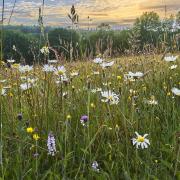A visit to Stroud and Stonehouse swiftly reveals their industrial heritage, with the infrastructure and architecture of the industrial revolution evident right along the course of the River Frome that allowed the wool industry to take off there. Aside from the mill buildings, perhaps the most evident remains of this past are the Stroudwater and Thames and Severn Canals. Today, they provide a lovely, often flower-filled place to walk and cycle, and it can be hard to imagine the work – all done by hand – that went into building them, and the busy industrial life that then followed.
Today’s walk starts in Eastington, about three miles from the start of the Stroudwater, where it intersects with Gloucester and Sharpness ship canal at Saul. When the M5 was built, the canal was split in two and the section around the motorway infilled, so we start our walk where it begins again. The Stroudwater was begun in the 1770s to bring coal to the mills, but the mill owners were worried about land ownership and disruption to their water supplies, and there were tales that as fast as the navvies dug out the canal, the locals filled it back in! In the end the canal couldn’t be stopped, and a wharf opened here at Chippenhams Platt in 1778, with 5,000 tons of coal landed there each year by the end of the 18th century.

As you walk alongside the tranquil canal with today’s main mode transport, the car, whizzing along beside you on its way to and from the motorway, spare a thought for the men who built these complex structures of cuts and locks and culverts. Known as ‘navvies’, from ‘navigators’, they were mainly British and Irish labourers brought in to do the hard work of digging out the earth for the canal navigations and puddling it with clay to make it watertight. These men worked and raised their families on the move around the UK in the canal and then railway boom-time. You can see this is a big canal, able to take the sailing barges or trows that worked the Severn, and deep enough to carry them. Imagine digging all that with picks and shovels, and wheeling the earth out on rickety planks laid up against the side of the cut.

When you reach the second bridge, cross the canal to the other side. This is a private bridge, called Newtown Roving Bridge, built to carry the drive of Eastington Park, which was built a few years after the canal was constructed. Continue on past Bond’s Mill with its Second World War tall block house, built to block German invaders, until you reach the new railway bridge by the Ocean, formed when a stream was dammed in constructing the canal. From there you can nip back over the canal to the Stonehouse Court Hotel – a 17th-century manor house – and visit pretty little St. Cyr, Stonehouse’s parish church.

We’re going to follow one of those navvies on a fishing trip away from the canal and down to the river, in a tale from Fiona Eadie’s book from local publisher the History Press, Tales from the Towpath. Follow the lane opposite the bridge to Stonehouse Court, crossing the Frome, and then under the railway. Turn right and follow the path through the meadows between two tributaries of the Frome. It was to here that Samuel, our navvie, would come to fish. Not for sport, but to supplement his family’s diet with something that he didn’t have to pay for, but earned through patience and quiet. That day, he caught two small trout for their tea, and cast out for one more. Sure enough, there was a tug on the line, and he pulled out a beautiful, glistening young perch. But this fish was something special – it seemed to Samuel that its scales gleamed gold and silver, and to his eye it was too beautiful to catch, so he let it go. He and his family enjoyed the two trout. He didn’t tell his wife about the one he let go – no one save himself, he reckoned, would understand how that one fish was a special one.

Navvies were not well-liked, often considered rowdy, drunken thieves by locals. Samuel knew this from all the navigation work he’d done before, so when, some weeks later, he was setting out to fish again in the same spot just past Bond’s Mill, his heart sank to see a group of local youths already there. They’d been drinking and immediately laid into him – and he ended up in the river. Like many people at that time, he couldn’t swim, and he sank down, splashing and choking on the water. Then, as he sank under the water, he felt something at his back, solid, strong, pushing him back up again, guiding him back. It was the golden perch! Alone and shivering on the bank, he shook his head. ‘One good turn deserves another,’ he thought, and called out his thank you to the river, then set out back home, glad to be alive.
Head on into the next field, and take the left-hand fork in the path. You’ll come out on Millend Lane in Eastington. Millend is the largest part of Eastington parish, developed by the owners of the mill that gave it its name. There’s been a mill at Millend since at least 1086, a corn and, later, a fulling mill for making woollen cloth. There were two more in the parish, Meadow Mill and Churchend Mill. Millend has been recently redeveloped, but you can still see the mill buildings. When you’ve had a look at the mills, turn right back to Churchend, and St. Michael’s church, set among meadows and orchards, a peaceful end to the busy history of industry and construction on both river and canal.
ESSENTIALS
Distance: 3.2 miles.
Duration: 1.5 hours.
Level: Easy; canal and riverside paths, can be boggy.
Parking: Street parking Eastington
Toilets and refreshments: Stonehouse Court by the canal on the edge of Stonehouse, the Old Badger Inn, a short walk down the road in Millend.
Transport links: Stagecoach bus 65 Dursley to Gloucester stops in the village, and the 64 from Stroud to Gloucester stops by the Travelodge, a short walk over the road to Eastington.
Further reading: Tales from the Towpath, by Fiona Eadie
LINKS
Route: gb.mapometer.com/walking/route_5461153
Stroudwater History: stroudwaterhistory.org.uk
Cotswold Canals Trust: cotswoldcanals.org
Kirsty Hartsiotis is based in Stroud and available as a storyteller and speaker. She is an Accredited Arts Society lecturer. Her books include Wiltshire Folk Tales and (with Anthony Nanson) Gloucestershire Ghost Tales and Gloucestershire Folk Tales for Children. She is also the curator of decorative art at a Gloucestershire museum.



























